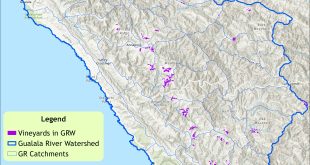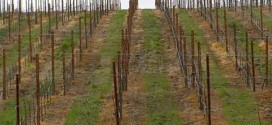That’s why the vineyard development that is eliminating the redwood forests of Annapolis is so important to the lower reaches of the Gualala River and its estuary.
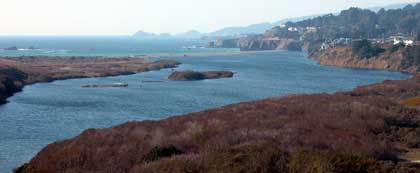
Gualala River estuary, full to the brim after the rains begin
copyright Friends of the Gualala River, October, 2004
In recent years new vineyards consuming millions of gallons of water have been developed throughout the tributaries of the Wheatfield and Buckeye Creek forks of the Gualala River. According to the California Department of Fish and Game, those two forks historically supplied 48% of the water to the Gualala Estuary.
Most existing open farmland in Annapolis has already been planted in grapes, and developers are resorting to clear cutting redwood forestland to make room for more grapes.
We do not know what the cumulative effects will be.
No unbiased, peer reviewed study has been conducted for the Gualala River watershed that evaluates the cumulative adverse effects of clear cutting large areas of forestland and converting them to intensively cultivated vineyards. The effects of these new vineyard developments must be evaluated within the context of the extensive historical and current damage to water quality that has occurred because of logging in the watershed.
Reports from the Department of Fish and Game and the North Coast Water Quality Control Board have outlined many existing and potential problems with clear cutting and vineyard development in Annapolis. Scientists from these agencies disagree with many conclusions presented in the vineyard conversion permit applications.
Water is already scarce in the Annapolis area.
In an attempt to soothe the fears of local residents and deflect the concerns of regulators, representatives of the vineyard developers claim that water usage will be less than the normally accepted standards for new vineyards because these new Annapolis vineyards will be dry farmed.
The only long established vineyard in Annapolis has already tried dry farming with vine density more widely spaced than usual at 800 plants per acre. This low density planting was recommended by the Mendocino County Cooperative Extension Office to compensate for a soil structure that does not retain adequate water for dry farming. Even with this low density planting, dry farming resulted in unprofitable yields. Dry farming was abandoned, local spring rights were purchased and the vineyard is now irrigated. When it comes to grapes and wine, water = profit.
Are the lowball estimates of water usage by these proposed new vineyards to be believed? The water extracted from wells is unregulated and once vineyard conversions are approved, developers can pump as much water as possible, regardless of what the original estimates were. No one checks.
The heaviest vineyard water usage is during the summer months when young steelhead in the Gualala River are dying from lack of water and elevated temperatures.
Developers in the Annapolis area have now purchased property solely for installing new wells and irrigating vineyards located several miles away. The water is trucked from the new well sites to the distant vineyards, because the wells located where the grapes are growing were pumped to full capacity and proved inadequate to the task.
Conversions are worse than clearcutting.
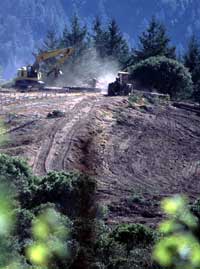 Worse than a Clearcut |
Scarcity of water is only one of many environmental concerns with the new vineyards.
The first step in converting a forest to a vineyard is to remove the entire forest. The results are much more extreme than the effect of normal clear cutting.
After removal and burning of all trees and brush, the soil is ripped several feet deep to remove all roots. Tons of lime are added to the soil to reduce the acidity. The land surface is graded and rainfall runoff patterns are disrupted and changed.
Peak flows will increase.
The Department of Fish and Game and the North Coast Water Quality Control Board have both pointed out that changes in land cover due to vineyard conversion can influence the size of peak flows in rivers and streams.
For example, rates of water infiltration and storage often change due to loss of vegetation by timber harvest. Further, infiltration rates also decrease as permeability of the land surface decreases. Decreased infiltration and storage of water causes streams and rivers to respond more rapidly to rainfall events. This can increase the frequency and severity of peak flows in the river and its tributaries.
The increase in surface runoff and decrease in infiltration reduces the natural groundwater storage that becomes available for summer base flow (Schueler, 1987).
High river peak flow events are indicative of the largest storms. Large storms typically bring high erosion and sediment transport events.
Increased frequency and severity of peak flows has many repercussions. Recovery intervals are decreased and the likelihood of inner gorge land sliding is increased. There is more frequent removal of riparian vegetation and redistribution of woody debris. As peak flows tear out the riparian vegetation there is less resistance to flow and water velocities increase, further heightening peak flows.
Increased peak flows have an even more dramatic immediate negative effect on headwaters and tributaries upstream than lower in the main trunk of the river. Most vineyard development in Annapolis is occurring on the ridge top headwater and recharge areas above the streams and rivers. The quality and quantity of water from these sensitive areas is being directly affected.
Roads = Sediment = Loss of Coho and Steelhead.
New dirt roads are being developed to move equipment through the vineyards. Several current vineyard conversion applications propose using several miles of poorly maintained existing dirt roads that run along a Class I steelhead stream as their only access route.
More permanent decreases in permeability occur due to road building and soil compaction. Road systems act as secondary drainage networks, further increasing the speed of runoff, the size of peak flows and increased sediment movement. Surface erosion from roads can produce chronic sources of fine sediment which can diminish salmon and steelhead spawning success.
The “Technical Support Document (TSD) for the Gualala River Watershed Water Quality Attainment Action Plan for Sediment (CWRCB, 2001)” found that roads were a major source of sediment in the Gualala basin. Road densities throughout the basin are well over the recognized thresholds for sediment yield that are likely to cause harm to spawning gravel conditions in areas downstream. The National Marine Fisheries Service (1996) set 2.5 miles of road per square mile as a target for properly functioning condition, while Cedarholm et al (1981) found the threshold for maintaining salmonid spawning gravel quality to be 1.6 miles per square mile in Washington State.
Fisheries biologist Patrick Higgins reports that the Annapolis Calwater Planning Watershed has six miles of road per square mile, more than double the level expected to cause problems of cumulative watershed effects.
Toxins flow downstream.
Municipal water systems that rely on the river downstream from these developments, including the Sea Ranch Water Company, now face the effects of agricultural chemical runoff.
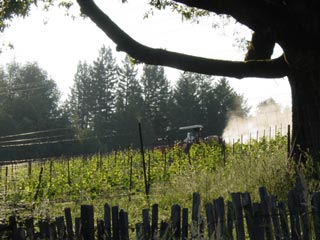
Pesticide application on an Annapolis vineyard
photo credit: C. Poehlmann, 2003
Fertilizer and agricultural chemical runoff is known to cause increases in algae growth in rivers with elevated temperatures. The Gualala River is listed as impaired by both excessive sedimentation and high temperatures. Conditions have already deteriorated to the point that steelhead in the Gualala have been listed as threatened and coho salmon have been listed as endangered under the Endangered Species Act.
Each vineyard project adds to pre-existing impacts.
For many years, the potential adverse effects of each new vineyard project were being evaluated individually by the California Department of Forestry rather than in combination with other existing vineyards and logging activities.
According to Patrick Higgins, “The Gualala Basin as a whole has numerous sub-basins that have had very high timber harvest rates between 1990 and 2001. 37% of the Annapolis Calwater Planning Watershed has been timber harvested between 1990 and 2001.” More has been harvested since 2001.
Higgins adds, “Reeves et al (1993) found that timber harvest in Oregon coastal basins over 25% of a watershed’s area caused loss of aquatic habitat diversity and loss of diversity of Pacific salmon species. Similar patterns are clear in the Gualala basin, as pools have filled in (Knopp, 1993) and coho salmon have been all but lost (CDFG, 2002).”
Environmental Impact Reports were not being prepared for these projects. They were routinely being approved through the use of “Negative Declarations,” in which the Department of Forestry certified that the projects would cause no significant adverse environmental impacts – without requiring a thorough study of the potential impacts.
In 2004, Friends of the Gualala River and the Sierra Club filed a lawsuit to stop this illegal practice. The court ruled that before the Department of Forestry can consider these vineyard conversion projects, it must prepare an Environmental Impact Report, so that potential adverse impacts can be considered, as California law requires.
The California Environmental Quality Act requires evaluation of the cumulative impacts of these projects combined with one another, combined with past projects, combined with present ones, and combined with forseeable future ones.
Such a cumulative impact evaluation has never been done for the combined vineyard and logging activities within the Gualala River watershed.
Vineyard developments in Annapolis threaten the quality of water in the watershed. Activities that lead to further degradation of water quality and fisheries habitat in the Gualala River should be prevented.
For more information
- Deforestation: News, Petition, etc.
- “Preservation” Ranch
- Worse than a Clearcut
- Vineyard conversions in Annapolis
- Artesa vineyard conversion
- Sonoma County General Plan “option 3”
- Press Articles
- Letters from experts and conservation groups
Other websites with information about vineyard conversions in the Gualala River watershed
- Redwoods Forever
- Russian River Residents Against Unsafe Logging
 Friends of Gualala River Protecting the Gualala River watershed and the species living within it
Friends of Gualala River Protecting the Gualala River watershed and the species living within it
